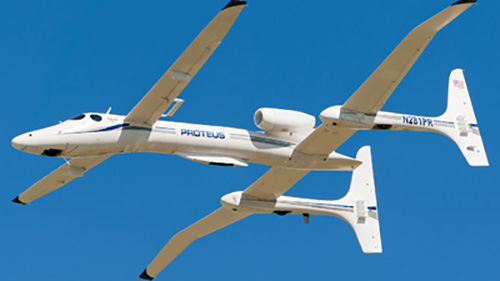

Cooperative Collision Avoidance Step 1
Technology Demonstration Flight Test Report. Revision 1
The National Aeronautics and Space Administration (NASA) Access 5 Project Office sponsored a cooperative collision avoidance flight demonstration program for unmanned aircraft systems (UAS).
This flight test was accomplished between September 21st and September 27th 2005 from the Mojave Airport, Mojave, California. The objective of these flights was to collect data for the Access 5 Cooperative Collision Avoidance (CCA) Work Package simulation effort, i.e., to gather data under select conditions to allow validation of the CCA simulation. Subsequent simulation to be verified were:
-
-
-
- Demonstrate the ability to detect cooperative traffic and provide situational awareness to the ROA pilot;
- Demonstrate the ability to track the detected cooperative traffic and provide position information to the ROA pilot;
- Demonstrate the ability to determine collision potential with detected cooperative traffic and provide notification to the ROA pilot;
- Demonstrate that the CCA subsystem provides information in sufficient time for the ROA pilot to initiate an evasive manoeuvre to avoid collision;
- Demonstrate an evasive manoeuvre that avoids collision with the threat aircraft; and lastly,
- Demonstrate the ability to assess the adequacy of the manoeuvre and determine that the collision potential has been avoided.
-
-
The Scaled Composites, LLC Proteus Optionally Piloted Vehicle (OPV) was chosen as the test platform. Proteus was manned by two on-board pilots but was also capable of being controlled from an Air Vehicle Control Station (AVCS) located on the ground.
For this demonstration, Proteus was equipped with cooperative collision sensors and the required hardware and software to place the data on the downlink. Prior to the flight phase, a detailed set of flight test scenarios were developed to address the flight test objectives. Two cooperative collision avoidance sensors were utilized for detecting aircraft in the evaluation: Traffic Alert and Collision Avoidance System-II (TCAS-II) and Automatic Dependent Surveillance Broadcast (ADS-B). A single intruder aircraft was used during all the flight testing, a NASA Gulfstream III (G-III). During the course of the testing, six geometrically different near-collision scenarios were evaluated.
These six scenarios were each tested using various combinations of sensors and collision avoidance software. Of the 54 planned test points 49 were accomplished successfully. Proteus flew a total of 21.5 hours during the testing and the G-III flew 19.8 hours. The testing fully achieved all flight test objectives. The Flight IPT performed an analysis to determine the accuracy of the simulation model used to predict the location of the host aircraft downstream during an avoidance manoeuvre. The data collected by this flight program was delivered to the Access 5 Cooperative Collision Avoidance (CCA) Work Package Team who was responsible for reporting on their analysis of this flight data.
Click to continue reading this article...
This article was originally published on NASA's Technical Reports Server: Document ID20080017394
